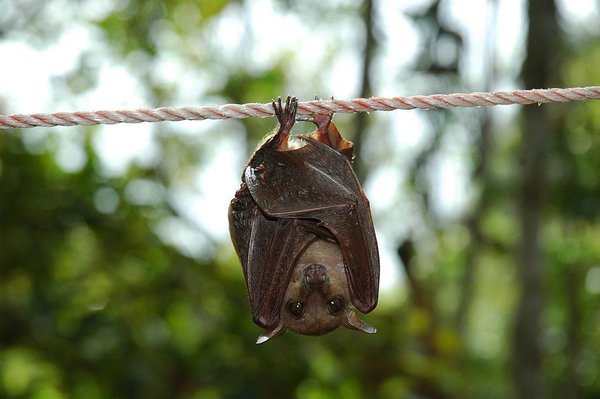Why is Ebola raging in DR Congo after a year?
Why is Ebola raging in DR Congo after a year?

Ebola nightmare still rages in DR Congo unabated nearly one year after the Health Ministry reported an outbreak. Why?
Ebola Virus Disease is a horrific virus with a high mortality rate, so much so that it is classified as a Category A bioterrorism agent. EVD is not (yet) an airborne virus like the Influenza viruses, and it is transmitted by contact with bodily fluids, such as blood, feces and vomit, milk, urine and semen, possibly also saliva and tears, more especially in the later stages of the illness. Some studies also indicate that it can be spread through sweat and contact with the body of someone infected or contact with contaminated surfaces.
Some say that the virus then needs to be passed to mucous membrane through touching the mouth, nose or eyes, others say it can be transmitted through lesions in the skin, while others state that it can be absorbed directly through the skin, in which case it is enough to touch an infected and contagious person.
A horror movie
Contagion occurs when a patient is infectious, in other words displaying the first symptoms, which is a sudden high fever, extreme fatigue, headache, sore throat, body pain and lack of appetite. This develops into nausea, then diarrhea and vomiting. As the virus takes hold and destroys the blood vessels, the central nervous system takes control from the digestive system and tells the body to expel as much fluid as it can through violent and sustained, copious projectile vomiting and diarrhea, which in the terminal stage can include blood. The patient becomes a human volcano of bodily fluids and torrents of blood.
An outbreak is caused by contact with an infected animal and a common vector (transmitting agent) is the fruit bat which is roasted and eaten in part of Africa. Primates, rodents and some plants are believed to be a possible source of transmission and therefore deforestation could be a factor in releasing the virus resevoir contained in the biome. The disease is named after the first patient in Zaire (now DR Congo), Mabalo Lokela, a school headmaster, died after visiting the Ebola River in the north of the country in 1976.
The patient lies extremely ill, with a fever, confused, unable to swallow, has difficulty in breathing and may suddenly start bleeding from the skin, the nose or even the eyes.
Shocking? Let us look at this most recent outbreak of Ebola Virus Disease in the Democratic Republic of Congo. The Health Ministry of this country reported an outbreak of EVD in North Kivu Province nearly one year ago, on August 18, 2018. The latest figures from June 10, 2019 indicate a total of 2071 cases (1977 confirmed, 94 probable) with 1396 deaths (1392 confirmed, 94 probable), a mortality rate of 67%.
But more shocking still is the fact that on May 11, 2017, the Health Ministry of DR Congo notified the World Health Organization about an outbreak of EVD. There were 4 deaths and 4 survivors and the outbreak was declared over in July of 2017.
In May 2018, the DR Congo reported 39 cases of EVD with 19 deaths. In July, the outbreak was declared over. A month later, the current outbreak was announced.
Fighting in the region over the mineral resources hampers the work of aid workers and medical teams.
What about treatment?
While as yet there are claims that effective treatment does not exist, there is the experimental drug Brincidofovir, administered during the West African Outbreak of EVD in 2016 to Thomas Eric Duncan unsuccessfully, there is the plasma treatment in which a patient receives a transfusion from an EVD survivor with the same blood type (as was the case of Nina Pham receiving plasma from Dr. Kent Brantly, one of the first two American citizens infected), and there is Z-Mapp, which was successfully administered to these two patients, Dr. Brantly and aid worker Nancy Writebol.
ZMapp is a treatment composed of the use of cultures of cells which make monoclonal antibodies, mAbs. The experimentation began with MB-003, a cocktail of three human/human-mouse mAbs, namely c13C6, h13F6 and c6D8, which showed promising results when administered to rhesus monkeys infected with EVD. The process evolved to the creation of ZMab, namely m1H3, m2G4 and m4G7. These also proved very promising in trials on Ebola-infected macaque monkeys. ZMapp humanized the three ZMab antibodies and tested these with combinations of MB-003 first in guinea pigs and then in monkeys. The best and most successful therapeutic combinations were the c13C6 from MB-003 and the humanized mAbs c2G4 and c4G7, from ZMab, and the result is what is known today as ZMapp.
During the West Africa outbreak of EVD, a medical team of Russian virologists, epidemiologists and bacteriologists was in the field in the Republic of Guinea, alongside humanitarian aid-workers. Russia sent doses of the anti-viral drug Triazavirin, which is effective in 70 to 90% of cases of infections with 15 strains of Influenza, including A H1N1 (Swine Flu) and H5N1 (Avian flu), at any stage of the infection.
On January 13, 2016, President Putin announced that Russia had developed a cure for EVD. In December 2015, Anna Popova, the Director of Rospotrebnadzor, declared that the documents for the registration of a vaccine against EVD had been delivered and Russian Health Minister Veronika Skvortsova declared that the clinical trials of the vaccine revealed a very high degree of efficiency.
Is the virus mutating?
So what, we may ask, is going on in DR Congo and why is the disease raging out of control? It has even spread to Uganda. Has the world gone back to a slumber of complacency because this is Africa, where shit happens?
History of EVD
The first outbreak took place in Sudan and was discovered only after it had ended, although at the time experts knew they weree dealing with a hitherto-unknown disease later named the Sudan variant (SUDV) of the genus of what would later in the year be identified as Ebola Virus Disease. Between June and November 284 people were infected with 151 deaths (53% mortality rate).
In August 1976, EBOV (Ebola Virus Disease) was identified as the cause of 318 cases with 280 deaths (88%) in Zaire.
Zaire, now known as Democratic Republic of Congo, experienced another outbreak in 1995 (EBOV) with 315 cases and 254 deaths (81%). Next in 2000, Uganda (SUDV) 425 cases, 224 deaths (53%); in 2003, DR Congo (EBOV) 143 cases, 128 deaths (90%); 2007, DR Congo with 264 cases and 187 deaths (71%); and the same year, Uganda with a new variant of the Ebolavirus genus, named after the place it was discovered, Bundibugyo with 149 cases and 37 deaths (25%).
In 2012, 2 outbreaks in Uganda (SUDV) with 7 cases and 4 deaths (57%) and 24 cases with 17 deaths (71%).
In 2012, DR Congo (Bundibugyo variant) 57 cases, 29 deaths (51%); 2014 DR Congo (EBOV) 66 cases, 49 deaths (74%).
The worst outbreak was the West African Outbreak (EBOV) (2013-2016) causing a total of 17.140 cases and 6.069 deaths (35%): Country, cases, deaths %mortality:
Liberia 7.635 3.145 41%
Sierra Leone 7.312 1.583 22%
Guinea 2.164 1.327 61%
Nigeria 20 8 40%
Mali 8 6 75%
Senegal 1 0 0%
plus some cases of deaths and survival among foreign aid workers who had become infected while working in the region.
...and in 2019 to date, a total of 2071 cases (1977 confirmed, 94 probable) with 1396 deaths (1392 confirmed, 94 probable), a mortality rate of 67%.
May we ask the question, if this was in Europe or North America, would the story be the same? If not, then why not?
Photo 1 Fruit Bat - By Unknown - http://sanisidro.gov.ph/mt-hamiguitan/, Public Domain, https://commons.wikimedia.org/w/index.php?curid=49770555
Photo 2: The author in 2018
Timothy Bancroft-Hinchey
Twitter: @TimothyBHinchey

Timothy Bancroft-Hinchey works in the area of teaching, consultancy, coaching, translation, revision of texts, copy-writing and journalism. Director and Chief Editor of the Portuguese version of Pravda.Ru since 2002, and now Co-Editor of the English version, he contributes regularly to several other publications in Portuguese and English. He has worked in the printed and online media, in daily, weekly, monthly and yearly magazines and newspapers. A firm believer in multilateralism as a political approach and multiculturalism as a means to bring people and peoples together, he is Official Media Partner of UN Women, fighting for gender equality and Media Partner with Humane Society International, promoting animal rights. His hobbies include sports, in which he takes a keen interest, traveling, networking to protect the rights of LGBTQI communities and victims of gender violence, and cataloging disappearing languages, cultures and traditions around the world. A keen cook, he enjoys trying out different cuisines and regards cooking and sharing as a means to understand cultures and bring people together.
Pravda.Ru
Subscribe to Pravda.Ru Telegram channel, Facebook, RSS!


